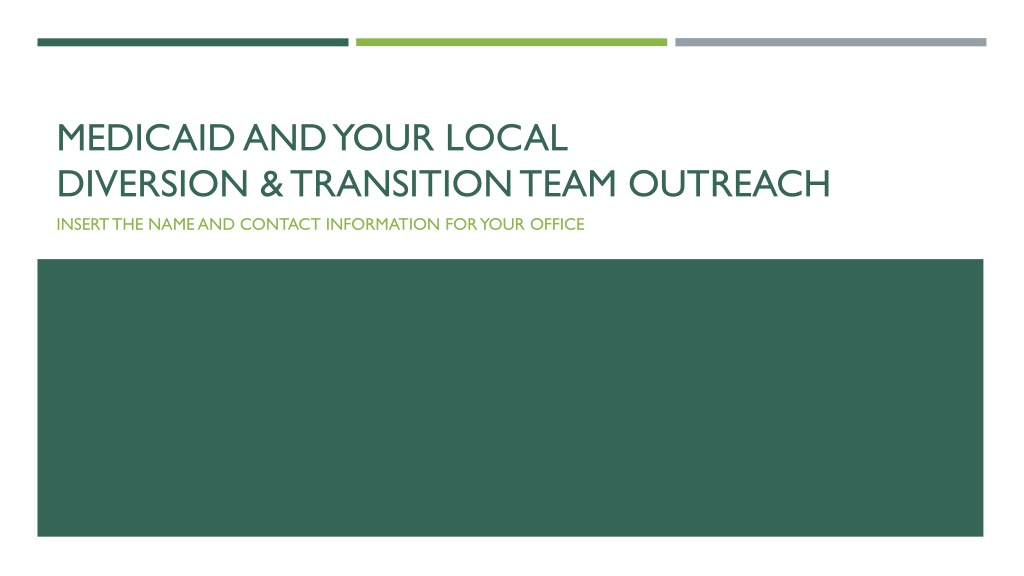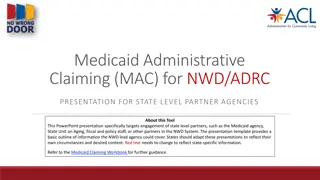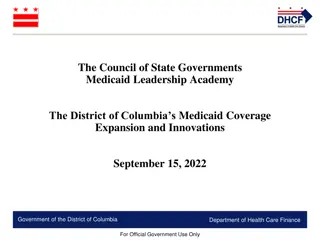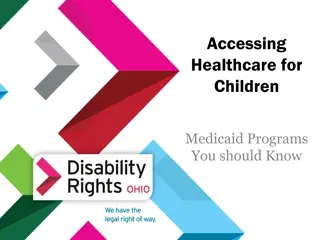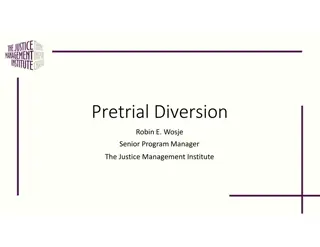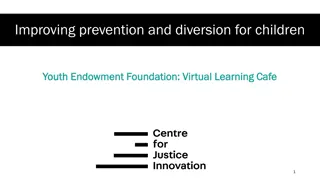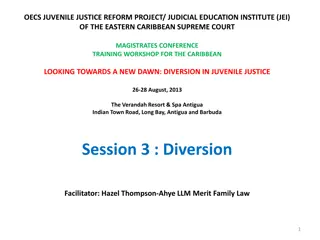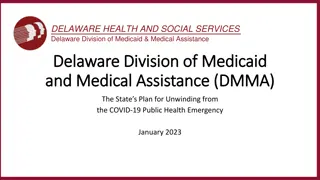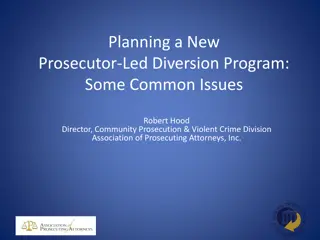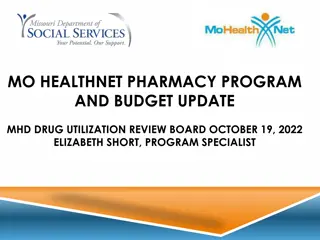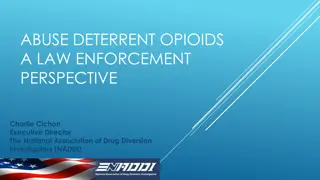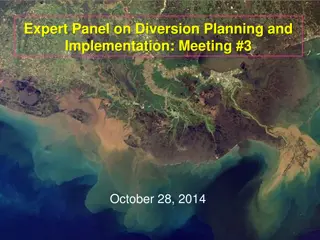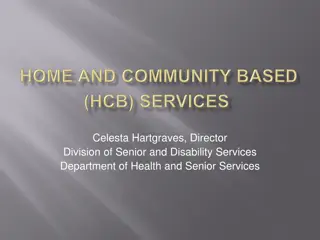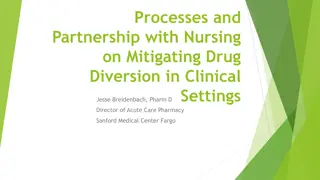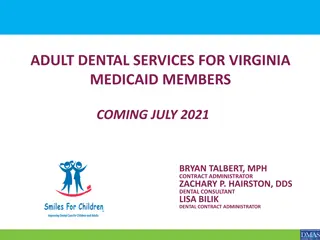Understanding Medicaid and Your Local Diversion & Transition Team
Learn about Medicaid, important acronyms, when to consider applying, what Medicaid can do, and who should make a referral. Find information on services, eligibility, and how Medicaid can support long-term care needs such as nursing facilities and assisted living. Explore resources for individuals unable to complete daily activities and discover how to contact your local diversion and transition team for assistance.
Download Presentation

Please find below an Image/Link to download the presentation.
The content on the website is provided AS IS for your information and personal use only. It may not be sold, licensed, or shared on other websites without obtaining consent from the author. Download presentation by click this link. If you encounter any issues during the download, it is possible that the publisher has removed the file from their server.
E N D
Presentation Transcript
MEDICAID AND YOUR LOCAL DIVERSION & TRANSITION TEAM OUTREACH INSERT THE NAME AND CONTACT INFORMATION FOR YOUR OFFICE
IMPORTANT ACRONYMS OR TERMS RELATED TO MEDICAID: AAA: Area Agency on Aging ACA: Affordable Care Act AFH: Adult Foster Home ALF: Assisted Living Facility APD: Aging and People with Disabilities CA/PS: Client Assessment and Planning System CBC: Community Based Care CM: Case Manager or Management CMS: Centers for Medicare and Medicaid Services DHS: Department of Human Services D/T: Diversion and Transition HCBS: Home and Community Based Services ICF: LTSS: Long Term Services and Supports MAGI: Modified Adjusted Gross Income NF: Nursing Facility OAR: Oregon Administrative Rule OHA: Oregon Health Authority OHP: Oregon Health Plan ORS: Oregon Revised Statutes OSIPM: OR Supplemental Income Program Medical QMB- Qualified Medicare Beneficiaries SNF: Skilled Nursing Facility Intermediate Care Facilities
WHAT IS MEDICAID? Medicaid Insurance Medicaid Long Term Services and Supports OHP Plus Services for consumers who can not complete activities of daily living (ADLs) OSIPM Home and Community Based Services MAGI In-Home Care Medical insurance coverage for Oregonians who meet low income eligibility standards. Community Based Care Adult Foster Home QMB Assisted Living Facility Medicaid program that helps people with Medicare part B premiums, deductible and co-insurance Residential Care Facility Institutional Based Care QMB-SMB & QMB-SMF: Pays for Medicare part B premium only Nursing Facility State Hospital OHP Plus Eligible
WHEN TO CONSIDER APPLYING FOR MEDICAID No Insurance Medicare only Medicare supplement that may not cover co-pays in there entirety Transportation needs outside of the facility. Client is considering long term care at the Nursing facility, In home or other Community Based Facility.
WHAT CAN MEDICAID DO? Can pay co-pays not covered by Medicare and/or supplemental Insurance. Can pay for long term care in the Nursing Facility, In home, Adult Foster Care, Memory Care and Assisted Living. Provide transportation to medical appointments outside of the facility.
WHO SHOULD MAKE A REFERRAL TO MEDICAID (IN ORDER OF PREFERENCE) Client Clients family Clients significant others Facility staff
WHAT DOES THE CALL DO? Provides information to potential client about eligibility Establishes a date of request for services ADD INFORMATION SPECIFIC TO YOUR OFFICE
WHAT INFORMATION IS NEEDED WHEN YOU CALL Name of applicant Social Security Number Date of Birth Address prior to admission Primary Diagnosis Phone number for primary contact/POA/Guardian Proposed discharge plan Date if admit to facility and hospital
WHAT INFORMATION IS NEEDED TO DETERMINE ELIGIBILITY FOR MEDICAID PROGRAMS Monthly gross income i.e. (social security, Annuities, pensions, Rental Income) Resources i.e. (money in the bank, stocks, bonds, retirement accounts, Life Insurance policies, home vehicles) Supplemental Health Insurance Coverage Long term care policies
INFORMATION SHARING BETWEEN APD/AAAAND NURSING FACILITIES APD staff must have immediate access to APD residents and to facility records, {411-070-0040(5)(b)}. APD staff have the right to privately interview APD residents, {411-070-0040(5)(c)}. APD staff have the right to participate in facility staffing's on APD residents, {411-070-0040(5)(d)}. Facility must provide access to residents to comply with state and federal rules/regs. Facility must provide notification of client s that no longer require NF care. Facility must cooperate with the Department s local representative in making discharge plans with the client.
462S WHAT DO THEY DO? Notifies DHS of admit and/or change in status. IF YOUR OFFICE USES OR WANTS TO IMPROVE THE USAGE OF A 462 PLEASE SEE THE NEXT 9 SLIDES TO INCORPORATE INTO YOUR PRESNTATION. IF YOUR OFFICE DOES NOT USE IT OR IS NOT INTERESTED IN INCREASING THE USAGE IN YOUR AREA THE NEXT 9 SLIDES CAN BE DELETED and your office should include slides covering your local process.
TOP SECTION 462 Nursing Facility Residents Change in Status Admission, Discharge, Transfer, Hospitalization or Change in Level of Care* Resident Name: Facility/ Medicaid Provider #: / Medicaid Number (or SSN): Facility Contact Name: DOB: Phone Number: Please complete in its entirety. Medicaid # or SSN, Facility Name and Provider #, Contact name and number.
SECTION 1 I. Type of Action: (please use one form per action) Admission (Complete Section II.) Hospitalization: Transfer to Hospital Hospitalization: Return from Hospital Leave of Absence: Transfer Leave of Absence: Return Change in Payment Status (Complete Section III.) Discharge (Complete Section IV.) Deceased Other: EFFECTIVE DATE OF ACTION: Check appropriate box, effective date, and if hospitalized indicate which hospital.
SECTION 2 II. Admission: ( Prior Authorization/PAS for Medicaid-funded service, PASRR Level I required) Primary Payor: Medicare (Title XVIII) Medicaid (Title XIX) Managed Care Other: Admitted From: Hospital Community Based Care Home Other: Level of Care: (*note: please do not use this form for CMAO) Basic PHEC (20 day max) Medicare Skilled Other: Primary Payor: Medicare-Medicare only, Medicare supplement Medicaid-Current Medicaid recipient, No Medicare Managed Care-Medicare Advantage plans or Medicaid Managed Care Other-Private Health Ins or No coverage
SECTION 2 CONTINUED II. Admission: ( Prior Authorization/PAS for Medicaid-funded service, PASRR Level I required) Primary Payor: Medicare (Title XVIII) Medicaid (Title XIX) Managed Care Other: Admitted From: Hospital Community Based Care Home Other: Level of Care: (*note: please do not use this form for CMAO) Basic PHEC (20 day max) Medicare Skilled Other: Admitted from: Which hospital, AFH or ALF/RCF, Home or other (please specify)
SECTION 2 CONTINUED II. Admission: ( Prior Authorization/PAS for Medicaid-funded service, PASRR Level I required) Primary Payor: Medicare (Title XVIII) Medicaid (Title XIX) Managed Care Other: Admitted From: Hospital Community Based Care Home Other: Level of Care: (*note: please do not use this form for CMAO) Basic PHEC (20 day max) Medicare Skilled Other: Level of Care: Basic ICF or LTC PHEC (Post Hospital Extended Care)-No Medicare, Medicaid only-3 day hospital stay, skilled need, up to 20 day (SEE NEXT SLIDE for additional information) Medicare Skilled-Up to 100 days with a 3 day qualifying stay.
CLIENT WITH NO MEDICARE OHP OR OSIPM ELIGIBLE (PHEC) Fee-for-service days (open card) up to 20 days: Managed care up to 20 days: If the individual has a 3-day qualifying hospital stay and a skilled service need (using Medicare criteria): No SPL requirement No liability No plan of care CMS no change Plan decides benefit and NF payment, no SPL. Plan will pay for a maximum of 20 days. Some CCOs will authorize additional skilled days if requested with appropriate documentation. SPL and plan of care needed at day 21. If there is no qualifying hospital stay or no skilled need: SPL is required Create a plan of care Compute liability Need OSIPM eligibility
Client with no Medicare Days 21 + (long-term care): SPL is required Create a plan of care Compute liability Need OSIPM eligibility No Medicaid OSIPM eligibility needs to be determined using 300% standard (may need PMDDT decision). Once determined, see fee-for-service above.
SECTION 3 III. Change in Payment Status: (*Please do not use this form for CMAO) Current Payor Source: Medicare (no copays) Medicare (with copays) Medicaid Private Insurance Other: New Payor Source: Medicare (no copays) Medicare (with copays) Medicaid (please do not use this form for CMAO) Private Insurance Other: Utilize this area when there is a change in payor status such as skilled to LTC, or private pay to Medicaid.
SECTION 4 IV. Transfer/Discharge: Own Home Relative s Home Nursing Facility Residential Care Facility Assisted Living Facility Please be specific about where resident discharged to for Example: Sleepy Hollow Nursing Facility. I Care Adult Foster Home. Adult Foster Home Homeless Shelter Alzheimer s Care Unit Enhanced Care Facility Other: Authorized Representative Signature Please sign and date Date
DIVERSION & TRANSITION SERVICES WHAT IS IT? Transition: Assist Medicaid approved consumers move from Nursing Facilities (skilled or ICF level of care) and other institutions such as Oregon State Hospital into community based care. Assisted Living Facility, Residential Care Facility, Adult Foster Home Specialized Adult Foster Home Memory Care Facility, In-Home. Diversion: Assist Medicaid approved consumers who are currently in an acute-care hospital setting or who are failing their current community based placement avoid long-term nursing facility placement. *Other options are available for private pay clients.
TRANSITION AND DIVERSION SERVICES HISTORY? WHY IT WAS IMPLEMENTED WHY ARE THEY AT MY FACILITY ORS 410.050 from 1981 found that the needs of the elderly population can best be served and planned for a the local community level. The Transition and Diversion teams are required to complete the Pre-Admission Screening found in Nursing Facility OAR 411-070 and to prevent long term institutionalization of Oregonians. On The Move is implemented through Money Follows the Person in 2008 and established larger teams across the state. They are there to provide placement options counseling to consumers new to LTSS House Bill 2216 in 2013 focused on Nursing Facility occupancy reduction and NF closures due to poor occupancy rates They establish Medicaid Service eligibility through the CA/PS assessment. They assist your facility s discharge planner with resources specific to Medicaid D/T eligibility and the local community. 2014 Affordable Care Act resulted in service eligibility for consumers previously ineligible for long term services and support bringing approx. 500 more Oregonians into long term care facilities.
TRANSITION/DIVERSION TEAMS WHAT DO WE DO? Service Option Counseling Meeting with consumer, family, and requested individuals to discuss potential placement options. Locate and present consumer with appropriate placement options. Provide access to placement options for individuals with complex care or behavioral needs. These options are only available when working with DHS Medicaid Case Manager or Diversion/Transition Coordinator. Provide follow-up for 90 days after placement with a goal of a safe and long-term stable placement. See following slides on how Oregon Administrative Rules governs their role.
BEHIND THE SCENES Services Transition/Diversion teams can offer to qualifying consumers wishing to leave institutionalized care. PURSUING AUTHORIZATION FOR MEDICALLY NECESSARY MEDICAL EQUIPMENT NOT OTHERWISE COVERED BY TRADITIONAL INSURANCE. Written insurance denial and physician order are required. AVAILABLE ASSISTANCE FOR CLIENTS WHO MEET ELIGIBILITY CRITERIA: Moving costs Basic household goods (cookware, tableware, furniture, bedding, linens, etc.) Basic personal items (basic food stocking, clothing, etc.) CRITERIA INCLUDE: Purchases are not intended to replace useable items already available to the consumer Consumers who do not already have items. Consumers with limited or no financial funds available. Must be based on an assessed need
OREGON ADMINISTRATIVE RULES (OARS) HOW THEY GOVERN THE WORK WE ALL DO OARs are defined as rules and regulations having the force of the law in the State of Oregon. These OARs guide the work that is required of Aging and People with Disabilities staff and partners at Area Agencies on Aging staff, as well as the providers across the state who have agreed to provide services to Medicaid consumers. The mission of Oregon s Department of Human Service which houses APD, contracts with AAAs, and enrolls Medicaid providers is: to help Oregonians in their own communities to achieve well-being and independence through opportunities that protect, empower, respect choice and preserve dignity.
OARS THAT GUIDE THE TRANSITION/DIVERSION PROGRAM & NF DISCHARGE PLANNING Transition/Diversion teams in your area were developed with the main purpose of meeting DHS s mission to serve Oregonians in the most independent community setting as possible based on the consumer s choice. The following presentation of rules related to Transition/Diversion program and NF discharge are intended to: Clarify the purpose of Transition/Diversion work Review of the rules that allow Transition/Diversion teams to work seamlessly with Nursing Facilities Identify the roles of T/D workers and NF staff
PRE-ADMISSION SCREENING Defined in OAR 411-070-0005 and described in OAR 411-070-0040 of the Chapter 411, Division 070: Nursing Facilities/Medicaid Generally and Reimbursement rule. Pre-Admission Screening (PAS)" means the assessment and determination of a potential Medicaid- eligible individual s need for nursing facility services, including the identification of individuals who can transition to community-based service settings and the provision of information about community-based alternatives. This assessment and determination is required when potentially Medicaid-eligible individuals are at risk for admission to nursing facility services. PAS may include the completion of the federal PASRR Level I requirement (42 CFR, Part 483, (C)-(E)), to identify individuals with mental illness or intellectual or developmental disabilities. It is an essential duty of Transition/Diversion teams.
PRE-ADMISSION SCREENING DUTIES: (2) PRE-ADMISSION SCREENING. A pre-admission screening (PAS) as defined in OAR 411-070-0005 is required for potentially Medicaid eligible individuals who are at risk for nursing facility services. (a) PAS includes: (A) An assessment; (B) The determination of an individual s service eligibility for Medicaid-paid long term care or post-hospital extended care services in a nursing facility; (C) The identification of individuals who can transition to community-based service settings; (D) The provision of information about community-based services and resources to meet the individual s needs; and (E) Transition planning assistance as needed.
PAS DUTIES CONTINUED (b) PAS is conducted in conjunction with the individual and any representative designated by the individual. (c) The PAS assessment shall be conducted by a case manager or other qualified SPD or AAA representative using SPD s Client Assessment and Planning System (CA/PS) tool, and other standardized assessment tools and forms approved by SPD. (d) A PAS may be completed based on information obtained by phone or fax only to authorize Title XIX post-hospital benefits in a nursing facility when short-term nursing facility services are needed. A face-to-face assessment including the discussion of alternative community based services and resources shall be completed within seven days of the initial, stort term nursing facility approval. (e) Payment for nursing facility services may not be authorized by SPD until PAS has established that nursing facility services are required based on the individual s service needs and Medicaid financial eligibility has been established.
PRIVATE ADMISSION ASSESSMENT Currently only the following Area Agencies on Aging are contracted with the State to provide these services: NorthWest Senior and Disability Services AAA Oregon Cascades West Council of Governments (OCWCOG) Medicaid enrolled Nursing Facilities in the following counties shall participate per OAR: 411-071-0000: Linn, Benton, Yamhill. Polk, Marion, Tillamook, Clatsop and Lincoln PRIVATE ADMISSION ASSESSMENT : A private admission assessment (PAA) is required for individuals with private funding who are referred to Medicaid-certified nursing facilities. The purpose of Private Admission Assessment is to ensure that non-Medicaid eligible individuals applying for or considering admission to a Medicaid certified nursing facility receive information regarding appropriate service and placement alternatives.
PASRR NOT TO BE CONFUSED WITH PAS OR PAA Despite the obvious acronym similarities Pre-Admission Screening and Resident Review (PASRR) is defined in OAR 411-070-0005 and described in OAR 411-070-0043 Definition: "Pre-Admission Screening and Resident Review (PASRR)" means the federal requirement, (42 CFR, Part 483, (C)-(E)), to identify individuals who have mental illness or developmental disabilities and determine if nursing facility service is required and if specialized services are required. PASRR includes Level I and Level II functions. PASRR Level 1 can be completed by different entities depending on the county. For new consumers some counties assign this duty to their local Transition/Diversion Coordinator or PAS nurse, other counties request that local hospitals complete this duty. For ongoing Medicaid consumers often the local ongoing Case Manger will complete this. PASRR Level 2 must be completed by Central Office Developmental Disabilities PASRR II Coordinator or the locally contracted Behavioral Health agency.
PRE-ADMISSION SCREENING/RESIDENT REVIEW (PASRR) CONTINUED Additional information on PASRR Level 1 & Level II A PASRR Level 1 is required for all nursing facility admissions. If indicated a PASRR Level II is required prior to admission or after a set number of exceptionally approved days PASRR is not a guarantee of payment. PASRR is not connected in any way to payment. Failure to have PASRR documents on file at survey could result in citations. In addition to PASRR requirements consumers with Mental Health indicators who are under 65 many not be eligible for Medicaid Long Term Care benefits through APD without prior approval from Central Office. This process is called a MED review.
PASRR LEVEL 1 REFERRAL PROCESS Local hospitals can complete the PASRR for skilled nursing facility admission. For intermediate care facility (ICF) admissions for Medicaid consumers in XXX County: Call the PASRR line, XXX-XXX-XXXX Leave client name, DOB, nursing facility discharge location, return fax number Fax a history and physical to XXX-XXX-XXXX Please note that the PASRR line is staffed during the following days and times: Requests received after 3:30pm will be returned the next business day See following slide for information on PASRR policy and PASRR Level II contacts.
PASRR COMPLIANCE CONTACTS PASRR Policy: Kathryn Nunley, 503-947-2309, Kathryn.m.nunley@state.or.us Intellectual and developmental disabilities (I/DD): Rachel Olson, PASRR Level II Coordinator, Rachel.olson@state.or.us Serious Mental Illness: Nirmala Dhar, 503-945-9715, Nirmala.dhar@state.or.us
OTHER KEY OARS AND CONTRACT REQUIREMENTS SHARED BY NURSING FACILITY OPERATIONS & POLICY ANALYSTS OAR Requirements APD/AAA staff access to information APD/AAA staff must have immediate access to APD residents and to facility records, {411-070-0040(5)(b)}. APD/AAA staff have the right to privately interview APD residents, {411-070-0040(5)(c)}. APD/AAA staff have the right to participate in facility staffing's on APD residents, {411-070-0040(5)(d)}. Contract Requirements APD/AAA staff access to information Facility must provide access to residents to comply with state and federal rules/regs. Facility must provide notification of client s that no longer require NF care. Facility must cooperate with the Department s local representative in making discharge plans with the client.
OTHER KEY OAR/CONTRACT INFORMATION CONTINUED OAR Requirements Consumer discharge planning The facility must assess resident s discharge potential. {411-086-0060 (1)(a)(H)} The resident care plan includes discharge planning. {411-086-0060 (2)(g)} The care plan must be updated when resident needs change {411-086-0060 (1)(a)} The care plan is reviewed and completed at an interdisciplinary meeting ( care conference ). {411-086-0060(2)(d)} Anyone the resident wishes to include may participate in the care planning meeting. {411-086-0060(2)(e)} Facilities must develop a discharge plan of care that will assist the resident to adjust to new living environment. {411-086-0160(2)(c)}
CONSUMER DISCHARGE PLANNING CONTINUED The social services staff must educate the resident and the resident s significant others about potential for discharge and the availability of alternate living services. {411-086-0240(2)(b)(I)(i)} Resident s potential for discharge and availability of alternate living services shall be assessed no less often than quarterly. {411-086-0240(2)(b)(I)(ii) The facility must assist with the development of discharge plan. {411-086-0240(2)(b)(I)(iii)} The facility must coordinate services required for resident s discharge. {411-086-0240(2)(b)(I)(iii)} Nursing Facility candidates for admission must be assessed and must receive information about community-based alternative services. {411-070-0040(1)}
BEST PRACTICES SUGGESTED BY NF OPA STAFF Are you unfamiliar with your local offices current practices? Would you like to get to know your local Transition/Diversion teams, PAS nurse (if applicable) and ongoing Case Managers better? The following practices are shown to improve the flow of work and information between the local office and local Nursing Facilities and other providers. Request regularly scheduled meetings with TCs, local manager(s) and NF leadership team. Request additional information from APD s Nursing Facility contract administrator Request guidance from APD s Safety, Oversight and Quality (SOQ) Unit assistance.
BARRIERS TO PLACEMENT: These barriers may potentially delay placement, not prohibit placement Specific geographic area Consumer preference vs consumer safety Assisted Living Facility for consumers under 65 Behaviors (verbal, physical, etc.) Available vacancies or independent housing options Requests for non-covered medical items or devices Requests for home modifications or repairs required for a consumer to return home Guardianship or Rep. Payee proceedings Requests for contracted or specialized living placement
CONTRACTED ADULT FOSTER HOMES AND COMMUNITY BASED CARE FACILITIES Contracted AFHs and CBC Facilities span state-wide. These homes and facilities are only available to consumers who are at risk for long-term institutionalization and are working with a Transition Coordinator or DHS Medicaid Case manager. The consumers who qualify for the contracted target group are not able to be served in a regular adult foster homes or CBC facilities due to their high level of care needs. The contracted target group contains a variety of consumer eligibility criterion that can only be verified by all of the following parties: the contracted provider, the local APD/AAA worker, and APD Central Office. Staff to consumer ratio is higher because the acuity of care is higher. This varies from contract to contract depending on the target group and the facility type
CONTRACTED ADULT FOSTER HOMES AND FACILITIES Types of contracted adult foster homes and community-based care facilities: Basic Advanced Complex ADL Behavioral (TBI, Dementia, etc.) Bariatric Hospice ** The terms basic, advanced and complex are in reference to staffing levels not the quality of care.**
CONTRACT BASICS What is the criteria for admission into contracted AFHs or CBC facilities? Each contract has it s own criteria for admission depending on the target group It is up to the worker from the local APD/AAA office, the APD contracted provider and APD Central Office to determine if the consumer meets criteria for admission. Until the local APD/AAA worker receives approval from APD Central Office the consumer cannot be placed in the contracted AFH or facility. Factors to consider Language that APD/AAA offices and providers use may have a slightly different meanings or uses APD RCFs with a Memory Care endorsement are the only secure options through Medicaid Long Term Supports and Services Services and staffing vary from contract to contract, please direct specific contract questions to your local office or specific-needs.contract-team@dhsoha.state.or.us
WHO ARE THE MEMBERS OF YOUR TRANSITION/DIVERSION TEAM? PAS Line XXX County Diversion/Transition T/D Team Contact Information Supervisor Intensive Case Manager Placement Specialist
OTHER CONTACT INFORMATION TAYLOR THIS TO MEET YOUR OFFICES NEEDS, INCLUDE SEVERAL CONTACTS OUTSIDE OF ELIGIBILTY INTAKE OR SCREENER LINE ADRC PASRR PAS APS LOCAL BEHAVIORAL HEALTH
